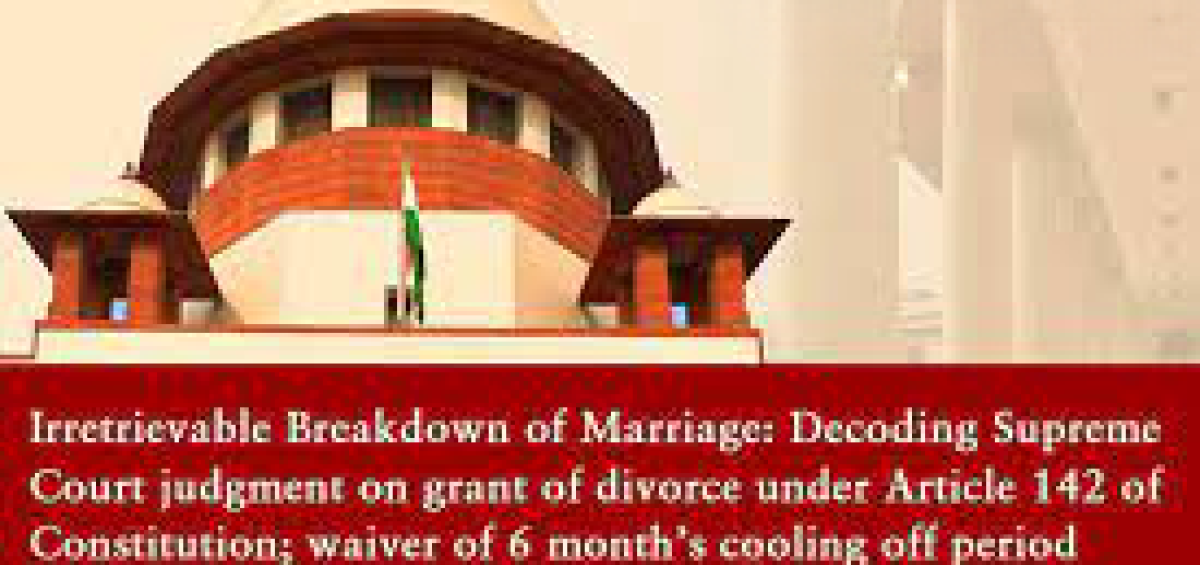Given the expansive amplitude of power under Article 142(1) of the Constitution, the exercise of power must be legitimate, and clamours for caution, mindful of the danger that arises from adopting an individualistic approach as to the exercise of the Constitutional power, observed the Supreme Court
Supreme Court: A Constitution Bench comprising of Sanjay Kishan Kaul, Sanjiv Khanna*, A.S. Oka, Vikram Nath, and J.K. Maheshwari, JJ. has held that the Supreme Court has the discretion to dissolve the marriage by passing a decree of divorce by mutual consent, without being bound by the procedural requirement to move the second motion subject to the requirements and conditions laid down under Amardeep Singh v. Harveen Kaur, (2017) 8 SCC 746 and Amit Kumar v. Suman Beniwal, 2021 SCC OnLine SC 1270. It was also held that in exercise of power under Article 142(1) of the Constitution of India, Supreme Court has the discretion to dissolve the marriage on the ground of its irretrievable breakdown.
However, while clarifying that whether a party can directly canvass before Supreme Court the ground of irretrievable breakdown by filing a writ petition under Article 32 of the Constitution, the Court said that the parties should not be permitted to circumvent the procedure by resorting to the writ jurisdiction under Article 32 or 226 of the Constitution.
Issues and Analysis:
Scope and ambit of power and jurisdiction of Supreme Court under Article 142(1) of the Constitution of India.
The Court took note of Article 142 of the Constitution and said that this Article is apparently unique as it does not have any counterpart in most of the major written constitutions of the world. Further, it said that Article 142(1) of the Constitution of India, which gives wide and capacious power to the Supreme Court to do ‘complete justice’ in any cause or matter’ is significant, as the judgment delivered by Supreme Court ends the litigation between the parties.
The Bench said that Article 142 gives legal authority to the Supreme Court to give precedence to equity over law. This power, like all powers under the Constitution, must be contained and regulated, as it has been held that relief based on equity should not disregard the substantive mandate of law based on underlying fundamental general and specific issues of public policy.
The Court while drawing a distinction between the Constitutional power exercisable by Supreme Court under Article 142(1) of the Constitution, and the inherent power of the Civil Court recognised by Section 151 of the Code of Civil Procedure, 1908 (‘CPC’) and the inherent power of the High Court under Section 482 of the Code of Criminal Procedure Code, 1973 (‘CrPC’) said that the Constitutional power conferred by Article 142(1) of the Constitution on Supreme Court is not a replication of the inherent power vested with the Civil Court under the CPC., and the High Court under the CrPC, as the plenary and conscientious power conferred on Supreme Court under Article 142(1), seemingly unhindered, is tempered or bounded by restraint, which must be exercised based on fundamental considerations of general and specific public policy.
Further, the Bench said that the fundamental general conditions of public policy refer to the fundamental rights, secularism, federalism, and other basic features of the Constitution of India. Specific public policy should be understood as some express pre-eminent prohibition in any substantive law, and not stipulations and requirements to a particular statutory scheme. It should not contravene a fundamental and non-derogable principle at the core of the statute.
The Court also said that it was never doubted or debated that this Court is empowered under Article 142(1) of the Constitution of India to do ‘complete justice’ without being bound by the relevant provisions of procedure, if it is satisfied that the departure from the said procedure is necessary to do ‘complete justice’ between the parties.1
The Court while taking note of Supreme Court Bar Assn. v. Union of India, (1998) 4 SCC 409, said that Supreme Court is not a forum of restricted jurisdiction when it decides and settles the dispute in a ‘cause or matter’ While this Court cannot supplant the substantive law by building a new edifice where none existed earlier, or by ignoring express substantive statutory law provisions, it is a problem-solver in the nebulous areas. As long as ‘complete justice’ required by the ‘cause or matter’ is achieved without violating fundamental principles of general or specific public policy, the exercise of the power and discretion under Article 142(1) is valid and as per the Constitution of India.
Further, the Court remarked that this is the reason why the power under Article 142(1) of the Constitution is undefined and uncatalogued, so as to ensure elasticity to mould relief to suit a given situation. Thus, the Court held that it can depart from the procedure as well as the substantive laws, if the decision is exercised based on considerations of fundamental general and specific public policy. While deciding whether to exercise discretion, the Supreme Court must consider the substantive provisions as enacted and not ignore the same. Although the Supreme Court acts as a problem solver by balancing out equities between the conflicting claims, this power is to be exercised in a ‘cause or matter’.
Can the mandatory waiting period of six months for divorce by mutual consent be dispensed with?
The Court while examining Section 13-B of the Hindu Marriage Act, 1955 (‘HMA’), noted that Section 13-B(2) HMA provides that after the first motion is passed, the couple would have to move to the Court with the second motion, if the petition is not withdrawn in the meanwhile, after six months and not later than eighteen months of the first motion. No action can be taken by the parties before the lapse of six months since the first motion.
The Court said that the legislative intent behind incorporating sub-section (2) to Section 13-B of the HMA, is that the couple must have time to introspect and consider the decision to separate before the second motion is moved. However, there are cases of exceptional hardship, where after some years of acrimonious litigation and prolonged suffering, the parties, with a view to have a fresh start, jointly pray to the Court to dissolve the marriage, and seek waiver of the need to move the second motion. Thus, because of irreconcilable differences, allegations made against each other and the family members, and in some cases multiple litigations including criminal cases, continuation of the marital relationship is an impossibility. Divorce is inevitable, and the cooling-off period of six months, if at all, breeds misery and pain, without any gain and benefit. As per the Court, here, the procedure should give way to a larger public and personal interest of the parties in ending the litigation, and the pain and sorrow effected by passing a formal decree of divorce, as in reality the marriage had ended much earlier.
The Court said that the object of the cooling off period is not to stretch the already disintegrated marriage, or to prolong the agony and misery of the parties when there are no chances of the marriage working out. Therefore, once every effort has been made to salvage the marriage and there remains no possibility of reunion and cohabitation, the Court is not powerless in enabling the parties to avail a better option, which is to grant divorce. The waiver is not to be given on mere asking, but on the Court being satisfied beyond doubt that the marriage has shattered beyond repair. The Court opined that Section 13-B HMA does not impose any fetters on the powers of Supreme Court to grant a decree of divorce by mutual consent on a joint application, when the substantive conditions of the Section are fulfilled, and the Court is convinced and of the opinion that the decree of divorce should be granted.Thus, adopting a hyper-technical view can be counterproductive, as pendency itself causes pain, suffering and harassment and, consequently, it is the duty of the Court to ensure that matrimonial matters are amicably resolved, thereby bringing the agony to an end.
Thus, the Court held that the Supreme Court has the discretion to dissolve the marriage by passing a decree of divorce by mutual consent, without being bound by the procedural requirement to move the second motion. This power should be exercised with care and caution, keeping in mind the factors stated in Amardeep Singh (supra) and Amit Kumar (supra)
Effect on ongoing proceedings under the Protection of Women from Domestic Violence Act, 2005, Section 125 of the Code of Criminal Procedure, 1973, or criminal prosecution primarily under Section 498-A and other provisions of the Penal Code, 1860
Placing reliance on Gian Singh v. State of Punjab, (2012) 10 SCC 303 and Jitendra Raghuvanshi v. Babita Raghuvanshi, (2013) 4 SCC 58, the Court also held that based on settlement between the parties, while passing a decree of divorce by mutual consent, can set aside and quash other proceedings and orders, including criminal cases and First Information Reports, provided the conditions, as specified in the judgments, are satisfied.
- Supreme Court’s power to grant divorce in exercise of power under Article 142(1) of the Constitution of India when there is complete and irretrievable breakdown of marriage despite the other spouse opposing the prayer
The Court took note of Section 13(1)(i-a) HMA and Section 23(1)(a) HMA and delineated the meaning of the term ‘cruelty’ by referring to its various judgments and said that the grant of divorce on the ground of irretrievable breakdown of marriage by Supreme Court is not a matter of right, but a discretion which is to be exercised with great care and caution, keeping in mind several factors ensuring that ‘complete justice’ is done to both parties. The Court should be fully convinced and satisfied that marriage is totally unworkable, emotionally dead and beyond salvation and, therefore, dissolution of marriage is the right solution and the only way forward.
- For this, several factors are to be considered such as:
- The period the parties had cohabited after marriage;
- When the parties had last cohabited;
- The nature of allegations made by the parties against each other and their family members;
- The orders passed in the legal proceedings from time to time,
- Cumulative impact on the personal relationship;
- Whether, and how many attempts were made to settle the disputes by intervention of the Court or through mediation, and when the last attempt was made, etc.
- The period of separation should be sufficiently long, and anything above six years or more will be a relevant factor.
Further, the Court clarified that these facts have to be evaluated keeping in view the economic and social status of the parties, including their educational qualifications, whether the parties have any children, their age, educational qualification, and whether the other spouse and children are dependent, in which event how and in what manner the party seeking divorce intends to take care and provide for the spouse or the children.
The Court said that extraordinary care and caution must be exercised, and unless it is shown that exceptional and special circumstances exist to demonstrate that substantial and grave injustice has been rendered, Supreme Court should not review/interfere with the decision appealed against. The Court would not pass an order in contravention or ignorance of a statutory provision, or merely on sympathetic grounds.
The Court read down the judgments in Manish Goel v. Rohini Goel, (2010) 4 SCC 393, Neelam Kumar v. Dayarani, (2010) 13 SCC 298, Darshan Gupta v. Radhika Gupta, (2013) 9 SCC 1, Hitesh Bhatnagar v. Deepa Bhatnagar, (2011) 5 SCC 234, Savitri Pandey v. Prem Chandra Pandey, (2002) 2 SCC 73 and others in the context of the power of Supreme Court given by the Constitution of India to do ‘complete justice’ in exercise of the jurisdiction under Article 142(1) of the Constitution. Thus, it was held that the power to do ‘complete justice’ is not fettered by the doctrine of fault and blame, applicable to petitions for divorce under Section 13(1)(i-a) of the Hindu Marriage Act.
Can a party directly canvass before the Supreme Court the ground of irretrievable breakdown by filing a writ petition under Article 32 of the Constitution?
After placing reliance on Poonam v. Sumit Tanwar, (2010) 4 SCC 460, the Court said that the parties should not be permitted to circumvent the procedure by resorting to the writ jurisdiction under Article 32 or 226 of the Constitution of India, as the case may be as the relief under Article 32 can be sought to enforce the rights conferred by Part III of the Constitution, and on the proof of infringement . Therefore, a party cannot file a writ petition under Article 32 and seek relief of dissolution of marriage directly from Supreme Court.
Thus, the Bench held that in exercise of power under Article 142(1) of the Constitution of India, has the discretion to dissolve the marriage on the ground of its irretrievable breakdown. This discretionary power is to be exercised to do ‘complete justice’ to the parties, wherein Supreme Court is satisfied that the facts established show that the marriage has completely failed and there is no possibility that the parties will cohabit together, and continuation of the formal legal relationship is unjustified. Further, it was said that the Court, as a court of equity, is required to also balance the circumstances and the background in which the party opposing the dissolution is placed.
[Shilpa Sailesh v. Varun Sreenivasan, 2023 SCC OnLine SC 544, decided on 01-05-2023]…





Leave a Comment